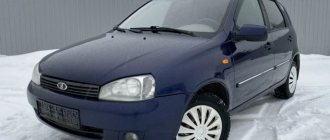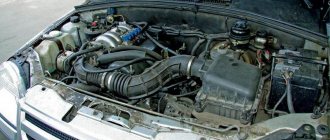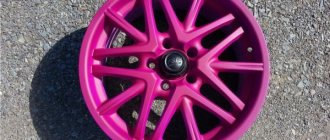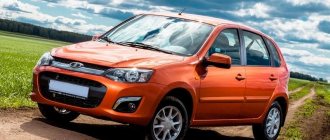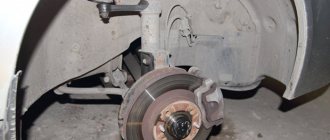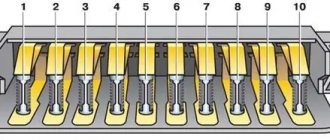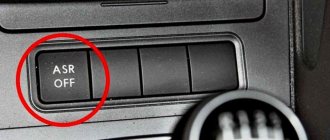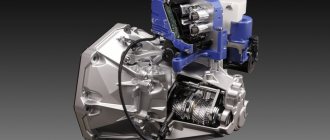In 2007, AvtoVAZ offered its customers a new model LADA Priora, which was a deep restyling of the VAZ-2110. In fact, it was a new car, created on the basis of the well-proven and proven “tens” model. The new product has a more proportional and aesthetic appearance, some technical problems have been eliminated, the anti-corrosion resistance of body panels has been enhanced, and the build quality has improved in comparison with its predecessors, which has made it possible to reduce the gaps between body parts. The new car was equipped with a 1.6-liter engine and a five-speed manual transmission.
Exterior
In terms of its design, Lada Priora has become a significant step forward in comparison with all its predecessors. The car had already received a modern design and did not seem archaic compared to foreign cars. The car had bumpers painted in body color, new optics and a new radiator grille, which significantly refreshed the appearance of this car. Of course, the Lada Priora did not match the design style of foreign cars of that time, but compared to the “ten” and other classic AvtoVAZ models, the new car was already a significant step forward.
Hatchback
Priora in this body appeared a little later. Outwardly, she looks more athletic and swift. That is why this body is loved by young, impulsive drivers. Also, this option is often subjected to tuning, turning a production car into a sports car.
The hatchback has a more spacious trunk. Which makes it more convenient for family people. In general, the body is somewhat shorter, which makes parking in the city more convenient. Due to the shorter body, the car corners much easier. There is practically nothing left of the dozen in the interior trim.
Interior
The interior of the car has changed significantly, the interior has become more interesting and richer. It is known that the designers developed the car interior together with specialists from an Italian studio. A trip computer appeared on the dashboard and the front dashboard was completely redesigned. On the central panel, where the oval clock is traditionally located, there was a silver trim, which refreshed the interior and made the interior more interesting to perceive. High-quality upholstery also appeared; this fabric retained its appearance for a long time and did not wear out.
Hatchback
This body type is ideal for traveling around the city. The short wheelbase slightly reduces the turning radius and allows you to maneuver comfortably among other cars. The hatchback also takes up little parking space, which is important in a big city. The rear window is usually quite large, gives a good view into the rearview mirror and has its own wiper blade.
But the hatchback also has its disadvantages. First of all, the trunk volume is small. Of course, if there are one or two people in the car, then you can fold or remove the rear seat back, but four people in such a car cannot go into nature.
Another negative side is that the trunk is combined with the interior. Since the bottom of the trunk of almost all models is poorly soundproofed, the noise level in the cabin is quite high. In addition, hatchbacks are rarely equipped with large engines, so it is not very convenient for country trips.
Motors used
The Lada Priora base received a 1.6-liter eight-valve engine, simple in design, developing 87 horsepower. This engine was also used on the VAZ 21114. Subsequently, based on this power unit, they offered an already modernized engine, which received 16 valves. This power unit developed 98 horsepower, which significantly improved the dynamics of the car and its maximum speed. At the same time, fuel consumption was at a minimum level; with a manual gearbox, such an engine consumed 7.5-8 liters per 100 kilometers. Also, a forced 1.6-liter engine was installed on the Lada Priora, which had variable intake geometry and its power was 106 horsepower.
Tell me what body is yours...
The car is available in four body styles, but the most popular versions are the sedan and hatchback. There are also station wagons and coupes, which are not as popular.
Let us remember that a sedan is a body with a luggage compartment, which is linearly separated from the passenger compartment. This is the most common body type among passenger cars. But the hatchback has a smaller trunk and a shortened rear overhang.
The trunk of the Lada Priora sedan holds 430 liters of cargo
Millimeter difference
Which is better - Lada Priora sedan or hatchback? Let's compare the dimensions. The Priora sedan is slightly longer than its competitor: 4350 mm versus 4210 for the hatchback. These models also differ in height: the hatchback has “grown” to 1435 mm, being 15 mm ahead of the sedan. But the width of the cars is equal, it is 1680 mm. Both cars also have the same ground clearance (165 mm) and track width of the front and rear wheels (1410 mm and 1380 mm, respectively).
An interesting point: the cars are almost identical in fuel consumption.
Your luggage
As we have already said, the sedan and hatchback differ in trunk capacity. In the case of the Priora, it looks like this... If the sedan takes 430 liters of cargo “on board”, then the hatchback in its original position is ready to take only 360 liters. At the same time, however, in the hatchback it is possible to fold the rear sofa and thereby increase the capacity of the luggage compartment to 705 liters.
If you fold the rear sofa of the Lada Priora hatchback, you get a cargo volume of 705 liters
Prices and options
Lada Priora, when compared with its direct predecessor VAZ-2110, received expanded equipment, including electric mirrors, a multiplex system, improved upholstery, as well as a number of other options that increased the level of comfort on board. The maximum configuration included heated seats, air conditioning, parking sensors, an alarm system and a number of other options. In terms of its technical equipment, such a car was no longer inferior to its classmates, including budget German and French cars.
The safety of the car has improved significantly, for example, the “Norma” package already included front seat belt pretensioners, a driver’s airbag and ABS. Starting from 2013, the Luxury package was already equipped with a stabilization system, four airbags, an auxiliary braking system, ABS and a rain sensor.
Having just appeared on the market for sale in 2007, the car was offered to customers at a price of 210 thousand rubles. Top trim levels, which had an expanded list of basic equipment, were offered at prices ranging from 250 thousand rubles or more. Options with a manual transmission were in greatest demand, but the automatic, due to its not very good reliability, was not in high demand among buyers.
Trunk
In a hatchback, the body is one-volume, since the trunk is not separated from the passenger compartment. Its cover is an additional door. This makes loading and unloading easier and makes it possible to get inside the car if, say, the locks of other doors freeze in winter. On the other hand, its opening quickly cools the air inside the car. Since the luggage compartment does not have sufficient sound insulation, the overall noise level inside the car increases. This is also facilitated by the knocking of the rear shelf, which appears when it is not securely fastened.
We recommend: Comparison of KIA Rio and Chevrolet Cruze
Despite the fact that the useful volume of the trunk in this case (here it is only 360 liters) is much lower than that of the sedan, with the rear seats folded down its volume almost doubles - to 705 liters. The rear seats, depending on the size of the cargo, can be folded either completely or partially. It becomes possible to transport large cargo: strollers, refrigerators, skis, garden tools, etc., which makes it practical in many cases.
Now let's look at: Priora sedan or hatchback, which is better in terms of other characteristics.
Advantages of Lada Priora
Among the advantages of this car, its owners noted the low cost and ease of repair and maintenance. This made it possible to significantly reduce the cost of operating the car; the car did not need to be taken to a service center; most repair work could be done with your own hands.
In comparison with its predecessors, the Lada Priora has noticeably improved the interior and design of the car; at one time it was already a modern car, which in design was practically not inferior to competing foreign cars.
The build quality has improved, this applies both to the body of the car, which no longer has gaps, but also to the interior, which no longer fell apart just a few years after the car began operating.
The sound insulation of the car has improved, and now traveling at high speed on the highway was no longer a torment for the driver and passengers. Also, the new car was a step forward in terms of safety; it already received an airbag as standard and a number of other options mandatory for modern cars.
Drawing conclusions
For the money, the Priora is a great car. Both in the city and on the dirt road he behaves purposefully. The body type has practically no effect on its “filling”. That is, the presence of air conditioning or electric power steering does not depend at all on whether you are driving a sedan or a hatchback.
The technical differences between the sedan and the hatchback are not that fundamental. This means that when choosing a Lada Priora sedan or hatchback, pay more attention. What do you like? A roomy classic car or a sports car with fancy taillights?
Also keep in mind that for a sedan you will pay a minimum of 345 thousand rubles, and for a hatchback they ask for a minimum of 354 thousand rubles. The cost of luxury versions starts from 442 thousand rubles for a sedan and from 446 thousand rubles for a hatchback.
When choosing a car, we pay attention not only to engine size, type of gearbox and its equipment. The choice of body type is important. Many people choose from a hatchback, station wagon or sedan on the basis of “I like those”, but do not forget that each body type was developed for specific purposes. Also, each of them has both its pros and cons.
Disadvantages of Lada Priora
The disadvantages of the Lada Priora include the corrosion resistance of the body, which, although it was improved, was not able to completely protect the metal from rust. Therefore, a few years after the start of operation of the car, the first traces of rust already appeared, which required expensive body repairs.
One serious drawback of this car is its mediocre reliability, which primarily concerned the electrics, as well as the powerful 16 valve engine. This engine often broke the timing belt, after which a major engine overhaul was required. The electrics constantly malfunctioned, and the automatic machine had a service life of about 100,000 kilometers before overhaul.
Also, many car owners made complaints about this car regarding its ground clearance. The ground clearance was minimal, which significantly complicated the ability to use this car on country roads; any trip out of town into the forest turned into a real torment and obstacle course for car owners.
4.03.2021
Station wagon
Essentially, a station wagon is an extended hatchback with a longer wheelbase. Due to its length, it is less maneuverable, but has an impressive trunk size. Typically, this type of vehicle is used for transportation, so station wagons are often equipped with large displacement engines and diesel engines. That's probably where the positives end.
The station wagon's interior is quite noisy, for the same reason as the hatchback's interior. The rear window is located quite far from the driver, so visibility in the rearview mirror is reduced. Due to the fact that the rear part is high, when reversing it is constantly scratched by low tree branches. And parking in such a car is not very convenient. This car is suitable for those who rarely visit a big city; rather, it is convenient for country trips.
Choice
It is possible to make the final choice of a car based on body shape only when purchasing a new model that has just left the showroom. When selecting a model on the secondary market, it is worth considering the current cost and general technical parameters. If the machine meets all the requirements for all the listed qualities, then it is advisable to purchase it.
During the body inspection, your own needs and wishes are taken into account. The purchased model should be as comfortable as possible and meet operating conditions.
If we analyze the cost of these two options, then the prices for the sedan are more affordable; on the secondary market they ask for 345 thousand rubles
., but a good hatchback will cost a little more -
354 thousand rubles
.
A solid sedan is suitable for commuting to the workplace; it is preferred by accomplished men. This is an excellent option for frequent highway driving without the additional burden of cargo. It has good dynamics and will easily take its owner to the workplace.
If commuting to work is combined with visits to wholesale food outlets or large shopping centers, then it is better to purchase a Priora with a spacious hatchback body.
Main differences
Experts note the following differences in these two modifications of the car:
- Common parameters
. The length of the car in the comfortable “sedan” modification is 4350 mm, height – 1420 mm, front wheel track width – 1410 mm, rear – 1380 mm. The hatchback is shortened in terms of dimensions: length 4210 mm, height parameters – 1435 mm. Thanks to the shortened rear end, parking and driving the comfortable hatchback are simplified. - Trunk capacity
. The trunk capacity of the sedan has a capacity of 430 liters, the hatchback can take up to 360 liters, and when the rear sofa is folded, this space expands to 705 liters. - There are differences in the installation of mandatory child seats - for a sedan this is done according to the UF type, for a hatchback - U.
Station wagon
This is the most spacious car in the series. Its capacity is 480 liters. If you fold down the rear seats, it's twice as big. This car is perfect for trips to the country with the whole family. Also, this choice will not be superfluous for lovers of long trips. The disadvantage is the worst handling of the entire series. The longer feed has an effect. But if the car is loaded, then it corners quite well.
In the parking lot, the car takes up quite a lot of space. Therefore, using it in the city is somewhat problematic. But for shopping trips it is ideal. There are no problems with visibility when moving backwards. Upgrading the interior (folding the seats) from the passenger version to the cargo-passenger version does not cause problems.
